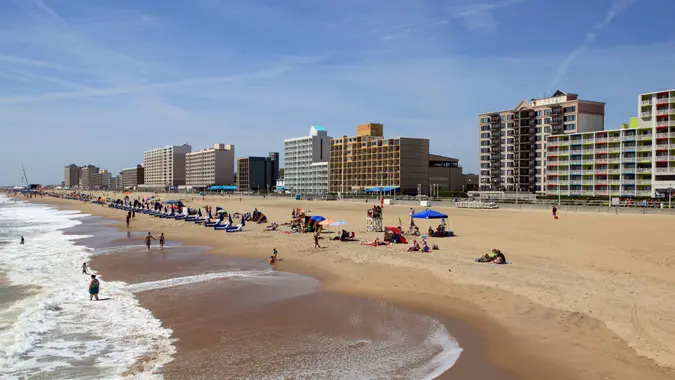Jaspreet Singh: You Must Commit To a ‘Decade of Sacrifice’ To Retire Early

Commitment to Our Readers
GOBankingRates' editorial team is committed to bringing you unbiased reviews and information. We use data-driven methodologies to evaluate financial products and services - our reviews and ratings are not influenced by advertisers. You can read more about our editorial guidelines and our products and services review methodology.

20 Years
Helping You Live Richer

Reviewed
by Experts

Trusted by
Millions of Readers
Many Americans dream of an early retirement, but are they ready to do the work it takes to get there?
According to Jaspreet Singh, CEO of Briefs Media and host of The Minority Mindset Show, anyone interested in becoming part of Financial Independence, Retire Early (FIRE) needs to put in what Singh calls the “decade of sacrifice” to get there.
GOBankingRates spoke to Singh about how to determine how much money you’ll need in retirement, the “drastic action” retirees that want to live off just Social Security must take and why Singh said he doesn’t follow the 4% rule when it comes to investing.
How much money do you think every American should aim to have in retirement savings and why?
The amount of money you need to retire and live comfortably is going to depend on your financial goals. I could make a blanket statement and say “you need $5 million dollars to retire,” but if your goal is to live on a small farm in Iowa and grow your own food, you won’t need that much money.
Let me break down how much money you need in two parts.
First, a reality check.
The unfortunate truth is that $100K doesn’t stretch as far as it did five years ago. That means you’re going to need more money to be financially free today than you did a few years ago. You can thank inflation for that.
Second, let’s figure out how much money you need.
If you listen to most traditional financial planners, they’ll tell you to follow the 4% rule. That means if you want to live off of $50,000 a year, you’ll need $1.25 million ($50K/4%) saved for retirement.
I don’t follow the 4% rule, because I like investing for cash flow. My goal isn’t to sell my investments to have an income. It’s to generate enough cash flow from my investments — real estate and dividend paying stocks — to cover my expenses.
I know that I can generate 3% to 10% in cash flow for every dollar that I invest. That means, if I want $50,000 a year in income, I will need somewhere between $500,000 ($50,000/10%) and $1.67 million ($50,000/3%) to live financially free.
Plus, this cash flow investing also fights off inflation, because if you invest in strong assets — your cash flow should grow with inflation.
What changes and plans should someone make if they plan to retire on only Social Security?
Social Security will, unfortunately, not pay you enough money to live financially free in retirement. If you are planning on living off of Social Security, I highly suggest you take drastic action to subsidize your Social Security income starting today.
This is going to be painful for many people to hear, but Social Security, even with the cost-of-living adjustments, is not keeping up with the higher cost of living. That means you may need to work to earn more money and spend less money today, so you can create some additional income from your investments.
How can you do that? Take a second job, work to get a promotion, start a business/side hustle and/or cut back on expenses.
Then, take this additional income and invest it into cash flow producing assets. A couple examples include dividend paying stocks/ETFs/index funds and rental real estate.
This way, you can start creating a new income stream for yourself. The initial learning curve will be tough, but if you do it correctly, it can pay you with cash flow for the rest of your life.
How should someone split their retirement investments among options like 401(k) plans, real estate and more?
When it comes to investing for retirement, I personally don’t use a 401(k) or an IRA. I prefer investing in real estate for the tax benefits.
I don’t recommend what I do to anyone else, because your goals, experience and risk tolerance are different from mine. For example, I like investing for cash flow. Meaning, I prefer investing into assets that pay me with regular income for owning them.
In the beginning of my investment journey, I put 100% of my investment money into buying rental properties. This approach made sense for me, because I began investing in real estate in 2011. This was when real estate prices were at rock bottom. I went all in with real estate investing.
Since beginning my investment journey, I’ve diversified a bit. These numbers are estimates, but it’ll give you an idea of what I do.
About 55% of my investment portfolio is real estate; 25% is stocks. 18% are speculative investments — like startups and crypto — and 2% is physical gold. Your investing style might change, depending on where you are in the economic cycle.
How should younger generations structure their retirement savings strategy differently than older generations?
The difference between investing today and 30 years ago is the speed at which businesses turn over. Technology, AI and the internet have allowed businesses to grow and crash at speeds we have never seen before.
Twenty years ago, some of the strongest companies in our economy were Sears and Bed Bath & Beyond. Now, both companies are bankrupt.
This is why smart investing is so important. If you plan on investing in individual companies — like Amazon, Apple or Chipotle — you have to continuously study your investments.
If you aren’t interested in keeping up with your investments, invest in funds that give you more diversification. This could be something like ETFs, index funds or mutual funds. You can invest in hundreds of stocks, which lowers your risk, by investing your money into one fund.
What is your best advice for someone interested in creating and implementing a FIRE plan?
When it comes to financial success, you cannot bypass hard work. This is what I call the “decade of sacrifice.” Put in the work to spend less and earn more for one decade.
Then, take the money that you don’t spend and invest this money aggressively. I prefer cash flow producing assets.
If you stick with this for 10 years, you’ll be able to build a whole new stream of income, which will let you live that FIRE lifestyle. It’s not rocket science. The more you put in, the more you’ll get out.
Jaime Catmull contributed to the reporting for this piece.
 Written by
Written by  Edited by
Edited by 

























